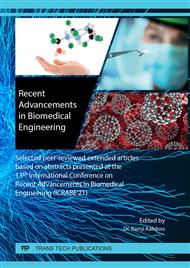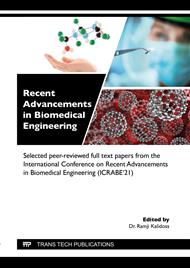[1]
M. Rai, J.C. Dos Santos, M.F. Soler, P. R. Franco Marcelino, L.P. Brumano, A.P. Ingle, S. Gaikwad, A Gade, S.S. Da Silva. Strategic Role of Nanotechnology for Production of Bioethanol and Biodiesel. Nanotechnol. Rev. 5, (2016) 231–250.
DOI: 10.1515/nano.0034.2015-0069
Google Scholar
[2]
K. Bhattarai, W.M. Stalick, S. Mckay, G. Geme, N. Bhattarai. Biofuel: An Alternative to Fossil Fuel for Alleviating World Energy and Economic Crises. J. Environ. Sci. Health Part A Toxic 46, (2011) 1424–1442.
DOI: 10.1080/10934529.2011.607042
Google Scholar
[3]
E.A. Shalaby. Biofuel: Sources, Extraction and Determination. In Liquid, Gaseous and Solid Biofuels; Fang, Z., Ed, IntechOpen: Rijeka, Croatia, (2013).
Google Scholar
[4]
J. Folaranmi. Production of Biodiesel (B100) from Jatropha Oil Using Sodium Hydroxide as Catalyst. J. Pet. Eng. 2013, (2013) 1–6.
DOI: 10.1155/2013/956479
Google Scholar
[5]
Forde, C.J, Meaney, M, Carrigan, J.B, Mills, C, Boland, S, Hernon, A. Biobased Fats (Lipids) and Oils from Biomass as a Source of Bioenergy. Bioenergy Res. Adv. Appl. (2014) 185–201.
DOI: 10.1016/b978-0-444-59561-4.00012-7
Google Scholar
[6]
M. Ahmad, M. Ajab, M. Zafar, S. Sult. Biodiesel from Non Edible Oil Seeds: A Renewable Source of Bioenergy. Econ. Eff. Biofuel Prod. (2011), (2005).
DOI: 10.5772/24687
Google Scholar
[7]
R. Mohadi, A.H. Harahap, N. Hidayati, A. Lesbani. Transesterification of Tropical Edible Oils to Biodiesel Using Catalyst From Scylla Serrata. Sriwij. J. Environ. 1, (2016), 24–27.
DOI: 10.22135/sje.2016.1.2.24-27
Google Scholar
[8]
M. Thirumarimurugan, V. M, Sivakumar, A.M. Xavier, D. Prabhakaran, T. Kannadasan. Preparation of Biodiesel from Sunflower Oil by Transesterification. IJBBB (2012), 441–444.
DOI: 10.7763/ijbbb.2012.v2.151
Google Scholar
[9]
B. Ahmmed, O.U. Samaddar, K.Q. Kibria. Production of Biodiesel from Used Vegetable Oils Production of Biodiesel from Used Vegetable Oils. Int. J. Sci. Res. Sci. Technol. (2019), 6.
DOI: 10.3989/gya.2008.v59.i1.494
Google Scholar
[10]
R.O. Do Nascimento, L.M. Rebelo, E. Sacher. Physicochemical Characterizations of Nanoparticles Used for Bioenergy and Biofuel Production. In Nanotechnology for Bioenergy and Biofuel Production; Rai, M., da Silva, S.S., Eds, Springer: Cham, Switzerland, 2017; p.173–191. ISBN 978-3-319-45459-7.
DOI: 10.1007/978-3-319-45459-7_8
Google Scholar
[11]
P.K. Dikshit, J. Kumar, A.K. Das, S. Sadhu, S, Sharma, S, Singh, P.K. Gupta, B.S Kim. Green Synthesis of Metallic Nanoparticles: Applications and Limitations. Catalysts, 11, (2021), 902.
DOI: 10.3390/catal11080902
Google Scholar
[12]
K. Saoud. Nanocatalyst for Biofuel Production: A Review. In Green Nanotechnology for Biofuel Production; Srivastava, N., Srivastava, M., Pandey, H., Mishra, P.K., Ramteke, P.W., Eds, Springer: Cham, Switzerland, 2018; p.39–62. ISBN 978-3-319-75052-1.
DOI: 10.1007/978-3-319-75052-1
Google Scholar
[13]
N.Singh, B.S. Dhanya, M.L. Verma. Nano-Immobilized Biocatalysts and Their Potential Biotechnological Applications in Bioenergy Production. Mater. Sci. Energy Technol. 3, (2020), 808–824.
DOI: 10.1016/j.mset.2020.09.006
Google Scholar
[14]
Ali, S, Shafique, O, Mahmood, S, Mahmood, T, Khan, B.A, Ahmad, I. Biofuels Production from Weed Biomass Using Nanocatalyst Technology. Biomass Bioenergy 139, (2020), 105595.
DOI: 10.1016/j.biombioe.2020.105595
Google Scholar
[15]
S.T, Hussain, S.A. Ali, A. Bano, T Mahmood . Use of Nanotechnology for the Production of Biofuels from Butchery Waste. Int. J. Phys. Sci. 6, (2011), 7271–7279.
Google Scholar
[16]
A.H. Hirani, N. Javed, M. Asif, S.K. Basu, A. Kumar A Review on First- and Second-Generation Biofuel Productions. In Biofuels: Greenhouse Gas Mitigation and Global Warming: Next Generation Biofuels and Role of Biotechnology; Kumar, A., Ogita, S., Yau, Y.-Y., Eds, Springer: New Delhi, India, 2018; p.141–154. ISBN 978-81-322-3763-1.
DOI: 10.1007/978-81-322-3763-1_8
Google Scholar
[17]
M. Puri, C.J. Barrow, M.L. Verma. Enzyme Immobilization on Nanomaterials for Biofuel Production. Trends Biotechnol. 31, (2013), 215–216.
DOI: 10.1016/j.tibtech.2013.01.002
Google Scholar
[18]
N.Shakeel, M.I. Ahamed, Ahmed, M.M. Rahman, A.M .Asiri. Functionalized Magnetic Nanoparticle-Reduced Graphene Oxide Nanocomposite for Enzymatic Biofuel Cell Applications. Int. J. Hydrog. Energy 44, (2019), 28294–28304.
DOI: 10.1016/j.ijhydene.2019.09.037
Google Scholar
[19]
J. Dantas, E. Leal, A.B. Mapossa, D.R. Cornejo, A.C.F.M. Costa. Magnetic nanocatalysts of Ni0.5Zn0.5Fe2O4 doped with Cu and performance evaluation in transesterification reaction for biodiesel production. Fuel 191, (2017), 463–471.
DOI: 10.1016/j.fuel.2016.11.107
Google Scholar
[20]
E. Cherian, M. Dharmendirakumar, G Baskar. Immobilization of Cellulase onto MnO2 Nanoparticles for Bioethanol Production by Enhanced Hydrolysis of Agricultural Waste. Chin. J. Catal. 36, (2015), 1223–1229.
DOI: 10.1016/s1872-2067(15)60906-8
Google Scholar
[21]
V. Ivanova, P. Petrova, J. Hristov. Application in the Ethanol Fermentation of Immobilized Yeast Cells in Matrix of Alginate/Magnetic Nanoparticles, on Chitosan-Magnetite Microparticles and Cellulose-Coated Magnetic Nanoparticles. arXiv preprint 2011, arXiv:1105.0619.
Google Scholar
[22]
K.H. Lee, I.S. Choi, Y.-G. Kim, D.-J. Yang, H.-J. Bae. Enhanced Production of Bioethanol and Ultrastructural Characteristics of Reused Saccharomyces Cerevisiae Immobilized Calcium Alginate Beads. Bioresour. Technol. 102, (2011), 8191–8198.
DOI: 10.1016/j.biortech.2011.06.063
Google Scholar
[23]
S. Duraiarasan, S.A. Razack, A. Manickam, A. Munusamy, M.B. Syed, M.Y. Ali, G.M. Ahmed, M.S. Mohiuddin, Direct Conversion of Lipids from Marine Microalga C. Salina to Biodiesel with Immobilised Enzymes Using Magnetic Nanoparticle. J. Environ. Chem. Eng. 4, (2016), 1393–1398.
DOI: 10.1016/j.jece.2015.12.030
Google Scholar
[24]
A. Wang, J. Wang, C. Lu, M. Xu, J. Lv, X. Wu. Esterification for Biofuel Synthesis over an Eco-Friendly and Efficient Kao- 610 linite-Supported SO42-/ZnAl2O4 Macroporous Solid Acid Catalyst. Fuel 234, (2018), 430–440.
DOI: 10.1016/j.fuel.2018.07.041
Google Scholar
[25]
S. Aquino Neto, T. S. Almeida, L. M. Palma, S.D. Minteer, A. R. De Andrade .Hybrid Nanocatalysts Containing Enzymes and Metallic Nanoparticles for Ethanol/O2 Biofuel Cell. J. Power Sources 259, (2014), 25–32.
DOI: 10.1016/j.jpowsour.2014.02.069
Google Scholar
[26]
Z.D. Yigezu, K. Muthukumar. Catalytic Cracking of Vegetable Oil with Metal Oxides for Biofuel Production. Energy Convers. Manag. 84, (2014), 326–333.
DOI: 10.1016/j.enconman.2014.03.084
Google Scholar
[27]
M. Akia, F. Yazdani, E. Motaee, D. Han, H. Arandiyan. A Review on Conversion of Biomass to Biofuel by Nanocatalysts. Biofuel Res. J. 1, (2014), 16–25.
DOI: 10.18331/brj2015.1.1.5
Google Scholar
[28]
V. Ganesh, A. Pandikumar, M. Alizadeh, R. Kalidoss, K. Baskar, Rational design and fabrication of surface tailored low dimensional Indium Gallium Nitride for photoelectrochemical water cleavage, Int. J. Hydrog. Energy., 45 (2020) 8198-8222.
DOI: 10.1016/j.ijhydene.2020.01.048
Google Scholar
[29]
A. Nzila. Mini Review: Update on Bioaugmentation in Anaerobic Processes for Biogas Production. Anaerobe, 46, (2017) 3–12.
DOI: 10.1016/j.anaerobe.2016.11.007
Google Scholar
[30]
X. Zhang, S. Yan, R.D. Tyagi, R.Y. Surampalli. Biodiesel Production from Heterotrophic Microalgae through Transesterification and Nanotechnology Application in the Production. Renew. Sustain. Energy Rev. 26, (2013), 216–223.
DOI: 10.1016/j.rser.2013.05.061
Google Scholar
[31]
A. Demirbas. Biofuels Sources, Biofuel Policy, Biofuel Economy and Global Biofuel Projections. Energy Convers. Manag. 49, (2008) 2106–2116.
DOI: 10.1016/j.enconman.2008.02.020
Google Scholar



